I am pleased to present another guest essay by Paul Meehan, author of Saucer Movies: A UFOlogical History of the Cinema (The Scarecrow Press, 1998), Tech-Noir: The Fusion of Science Fiction and Film Noir (2008), Cinema of the Psychic Realm: A Critical Survey (McFarland, 2009), and most recently, Horror Noir: Where Cinema’s Dark Sisters Meet (McFarland, 2010). In this piece, Meehan examines a neglected facet of Spielberg’s Close Encounters of the Third Kind, that of the phenomenon of remote viewing, exemplified when several characters receive a psychic image of what turns out to be Devil’s Tower, Wyoming after their encounter with UFOs. Meehan explores the connection between remote viewing and UFO researcher Jacques Vallee.
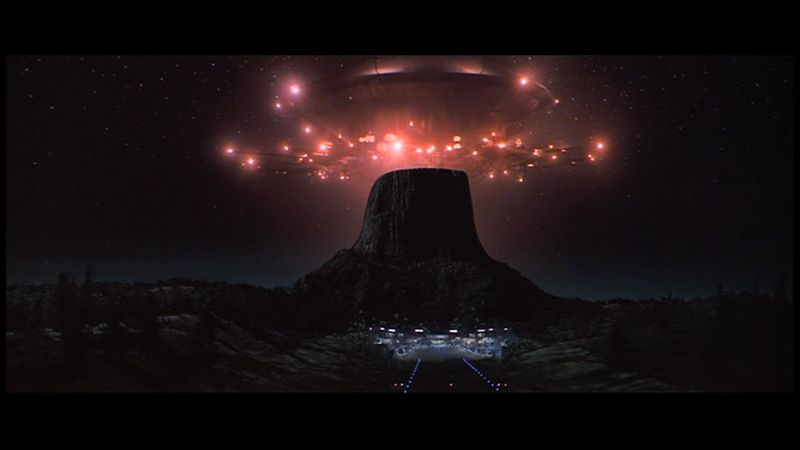 “ZEY BELONG HERE MORE ZAN WE”: REMOTE VIEWING AND CLOSE ENCOUNTERS OF THE THIRD KIND
“ZEY BELONG HERE MORE ZAN WE”: REMOTE VIEWING AND CLOSE ENCOUNTERS OF THE THIRD KIND
By Paul Meehan
Stephen Spielberg’s 1977 UFO epic Close Encounters of the Third Kind was a critical and popular success that, along with Star Wars, which was released in the same year, ushered in a revival of the science fiction film that has continued to this day. It remains the most profound and insightful treatment of the UFO subject in the history of the cinema. This was because Spielberg, who also scripted, eschewed science fiction concepts of alien life in favor of material culled from real-world UFO reports.
During the scriptwriting process, Spielberg consulted with two scientists who were the world’s foremost authorities on the subject. Northwestern University astronomer Dr. J. Allen Hynek, who had been scientific consultant to the Air Force’s saucer-busting unit Project Blue Book, acted as technical consultant on the film and makes a brief cameo appearance during the climactic scene of Close Encounters. French astrophysicist and computer scientist Dr. Jacques Vallee, who had authored several important books on the subject, was the template for French ufologist Claude Lacombe, played by Francois Truffaut in the film.
But there were a number of curious UFO sub-plots in Close Encounters that incorporated material that seem to have been gleaned from the U.S. Government’s research into psychic remote viewing. In my 1998 book Saucer Movies: A UFOlogical History of the Cinema, I discussed this topic in connection with conspiracy theories about covert government involvement in the making of Hollywood films about UFOs. While I do not give these theories any credence, Close Encounters does contain RV plot elements that are puzzling and have never been explained.
The government’s psi-spy program began at Stanford Research Institute, a University think-tank near Palo Alto, California, in the early 1970’s. At SRI, respected physicists Russell Targ and Harold Puthoff conducted scientifically-controlled experiments into ESP functioning with renowned psychics like Uri Geller and Ingo Swann that produced compelling results and received funding from the CIA. Swann would become the group’s theorist and would devise the protocols for the psychic system that would come to be called “co-ordinate remote viewing” or CRV. He was assisted at this task by a computer scientist who was also working at SRI named Jacques Vallee.
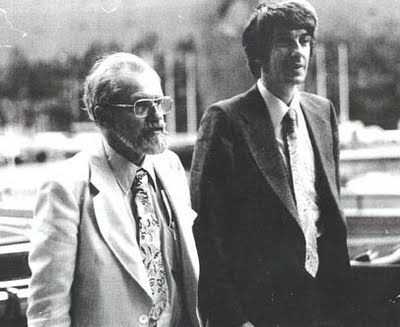 According to some accounts, Vallee’s initial contribution to the genesis of RV was severely circumscribed due to lack of funding, and therefore he was employed only as an unpaid consultant during the early 1970s. Later on, however, when the project had moved into a military phase and was codenamed “Grill Flame” (1978-1982), Vallee was formally initiated into the mysteries of RV by Ingo Swann, reportedly to analyze links between remote viewing and the UFO phenomenon.
According to some accounts, Vallee’s initial contribution to the genesis of RV was severely circumscribed due to lack of funding, and therefore he was employed only as an unpaid consultant during the early 1970s. Later on, however, when the project had moved into a military phase and was codenamed “Grill Flame” (1978-1982), Vallee was formally initiated into the mysteries of RV by Ingo Swann, reportedly to analyze links between remote viewing and the UFO phenomenon.
In 1973, Swann was struggling to formulate the basic procedures needed to utilize psychic functioning for intelligence purposes. His problem was in directing the remote viewer to the target site that the spies wanted to look at without telling the viewer too much about it. As journalist Jim Schnabel writes in his book Remote Viewers, if a psychic spy was tasked with viewing Ramenskoye Airfield, near Moscow, “then whatever psychic impressions he might have of the airfield would probably be overwhelmed by his imagination–which would find it all too easy to conjure up scenes of massive runways and hangars. What was needed was a way to be directed to a target, precisely and economically, without actually being told what the target was.” Taking a cue from computer programming, Vallee suggested to Swann that what he needed was to designate an “address” to direct the viewer’s vision to. Swann refined this idea into a procedure that used geographical latitude and longitude co-ordinates to indicate the target site.
Swann, who was an artist as well as a psychic, devised an intricate set of protocols for his system of co-ordinate remote viewing. The viewer was given latitude and longitude co-ordinates of the place to be viewed, and would then attempt to render their visual impression of what was at the co-ordinates. The viewer would begin by drawing an ideogram, a simple shape which would contain the basic design elements, the gestalt of the target: a squiggly line could indicate a river; a triangle might represent a jagged mountain peak. Elaborating on the ideogram, the viewer would produce more and more detailed drawings of increasing complexity that pictured the target site. In the final phase of the process (referred to as stage 6), the viewer would construct a three-dimensional model of the target. Author Jim Schnabel, for instance, who was trained in RV by Swann as part of his research, constructed a scale model of the target he had successfully viewed, the Tower of the Americas in San Antonio during Stage 6 of his training.
Remote viewing is an intensely visual process, and researchers soon discovered that some targets were much more “viewable,” or “RV-friendly” than others. Targets that were visually arresting seemed to attract a viewer’s attention much more readily than sites with visually uninteresting optics. Therefore, targets that have a “sexy,” or dramatic visual gestalt, such as, for example, Niagra Falls, the Sphinx or Devil’s Tower, Wyoming are like psychic beacons that seem to attract a remote viewer’s attention.
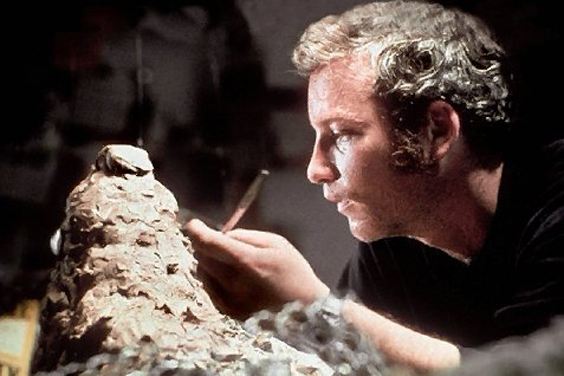 In Close Encounters, electrical worker Roy Neary (Richard Dreyfuss) has an alien transmission telepathically implanted in his mind after an encounter with a UFO. Afterwards, Neary becomes obsessed with sculpting a strange-looking shape out of shaving cream and mashed potatoes. In remote viewing parlance, Neary has received the ideogram, a vague visual impression of the target site that will be refined until it is identifiable. His neighbor, Jillian Guiler (Melinda Dillon), who has also encountered the aliens, begins painting watercolors of an odd, flat-topped mountain peak.
In Close Encounters, electrical worker Roy Neary (Richard Dreyfuss) has an alien transmission telepathically implanted in his mind after an encounter with a UFO. Afterwards, Neary becomes obsessed with sculpting a strange-looking shape out of shaving cream and mashed potatoes. In remote viewing parlance, Neary has received the ideogram, a vague visual impression of the target site that will be refined until it is identifiable. His neighbor, Jillian Guiler (Melinda Dillon), who has also encountered the aliens, begins painting watercolors of an odd, flat-topped mountain peak.
In the meantime, French scientist Claude Lacombe (Francois Truffaut), who heads a UN group striving to contact an alien intelligence that has mysteriously manifested itself on Earth, intercepts a series of numbers being beamed down from outer space. David Laughlin (Bob Balaban), a cartographer who has accidentally joined the project and serves as Lacombe’s interpreter, notices that the numbers correspond to latitude and longitude co-ordinates for Devil’s Tower, an imposing mesa located in Wyoming, and Lacombe realizes that this site is where the extraterrestrials will make contact. So, indirectly, Jillian and Neary have “remote viewed” the target that lies at these geographical co-ordinates. Note that Devil’s Tower is a site with a dramatic visual gestalt that is amenable to psychic viewing.
Neary’s obsession with the strange shape eventually leads him to construct a gigantic, incredibly detailed model of Devil’s Tower in his rec room. In remote viewing terms, he is performing a stage 6 exercise, the sculpting of a precise model of the target. When he happens to see a broadcast about Devil’s Tower on TV, Neary realizes that he must go there and he and Jillian travel to Wyoming. En route to the contact site they are captured by the military and Neary is interrogated by Lacombe, who shows him a number of other paintings and drawings of Devil’s Tower made by others who have also traveled to there and been taken into custody. Lacombe believes these people have “invited” to the contact site and should remain, but he is overruled by the project’s military commander, who insists they be airlifted out, causing Lacombe to lament, “Zey belong here more zan we.”
Jillian and Neary manage to escape from the soldiers ,and Neary guides them to a box canyon at the foot of the mesa that he has viewed and had sculpted on his elaborate model. The canyon turns out to be the contact site, where Lacombe and his group have set up a hi-tech facility. Contact is made as the aliens descend from the skies and Neary is rewarded for his psychic acumen by being allowed to board the mothership and go on a journey into outer space.
T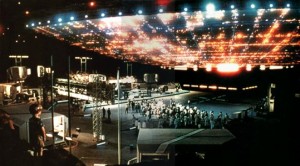 hese remote viewing themes are central to the plot of Close Encounters and figure prominently in the film’s narrative. Neary’s receipt of the Devil’s Tower ideogram from the aliens and his attempts to solve the puzzle provide much of the dramatic focus of the first two thirds of film. Also, the cartographer character played by Bob Balaban seems to have been inserted into the plot specifically to identify the geographic co-ordinates of the alien’s landing site.
hese remote viewing themes are central to the plot of Close Encounters and figure prominently in the film’s narrative. Neary’s receipt of the Devil’s Tower ideogram from the aliens and his attempts to solve the puzzle provide much of the dramatic focus of the first two thirds of film. Also, the cartographer character played by Bob Balaban seems to have been inserted into the plot specifically to identify the geographic co-ordinates of the alien’s landing site.
Another connection between Close Encounters and remote viewing lies in the fact that RV has long had associations with the UFO phenomenon. In his 1990 book Out There, Pulitzer-nominated investigative journalist Howard Blum recounts how an SRI psychic inadvertently viewed a UFO during a remote viewing demonstration being conducted for military bigwigs in the Old Executive Office Building of the White House in 1985. He also relates how Army remote viewers were called on to provide information regarding an anomalous object detected by the U.S. Space Command in December, 1986. Several former government viewers, including Joe McMoneagle and Ingo Swann reportedly had spontaneous and unexpected encounters with UFOs and aliens during viewing sessions. The true extent of the connection between government remote viewers and UFOs remains clouded in official secrecy and has become a controversial issue in the history of RV.
It would appear that Spielberg was well acquainted with details of the government’s co-ordinate remote viewing program when he wrote the script for Close Encounters, as specific concepts and procedures are woven into the plot of the film, albeit in an indirect fashion. While some accounts of the SRI co-ordinate remote viewing experiments had been written about in books and magazines, the precise CRV protocols developed by Swann were not, nor was the fact that these techniques were being used in American espionage and were principally funded by the CIA and other government agencies. The connection between RV and UFOs was likewise unknown to the general public.
Conspiracy-minded ufologists have posited an effort by U.S. intelligence agencies to “educate the public” about the reality of the alien presence by producing Hollywood films on UFOs. In the case of Close Encounters, a more likely scenario is that Vallee might have revealed information to Spielberg about the SRI CRV project, which the director then incorporated into his screenplay. Although Spielberg and Vallee have said nearly nothing about their association with each other during the making of the film (they reportedly did not meet until the movie was nearly finished), Vallee was the only person who was sufficiently knowledgeable about both UFOs and CRV who could have advised him about these anomalous subjects.
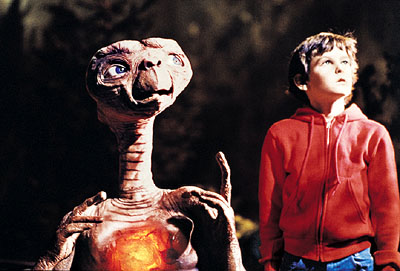 While Spielberg’s protagonist in Close Encounters is everyman Roy Neary, there are also a number of espionage/paranoia/conspiracy motifs in the film as the secret UN saucer group silences UFO witnesses and the U.S. military stalks American citizens in unmarked helicopters in violation of Posse Comitatus laws. Be it also noted that telepathic aliens and psychic warfare themes appear in other Spielberg movies. In E.T., The Extraterrestrial (1982) a boy establishes a telepathic link with an alien being who is being pursued by another government “silence group,” while in Indiana Jones and the Crystal Skull (2008) a Soviet psi-spy seeks to obtain an alien artifact that will enable psychic mind control on a mass scale.
While Spielberg’s protagonist in Close Encounters is everyman Roy Neary, there are also a number of espionage/paranoia/conspiracy motifs in the film as the secret UN saucer group silences UFO witnesses and the U.S. military stalks American citizens in unmarked helicopters in violation of Posse Comitatus laws. Be it also noted that telepathic aliens and psychic warfare themes appear in other Spielberg movies. In E.T., The Extraterrestrial (1982) a boy establishes a telepathic link with an alien being who is being pursued by another government “silence group,” while in Indiana Jones and the Crystal Skull (2008) a Soviet psi-spy seeks to obtain an alien artifact that will enable psychic mind control on a mass scale.
Details of the U.S. Government’s remote viewing programs were not made public until 1995, almost 20 years after the initial release of Close Encounters. It is only now that the influence of RV as an inspiration for the plot of this classic science fiction film can be appreciated.





Close Encounters occurred at Coleman
AFB in NM.